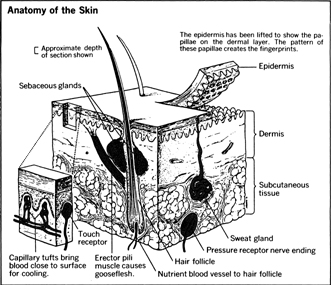The Skin - Skin color
The basic skin color of each person is determined at birth, and is a part of his heritage that cannot be changed.

Melanin
There are four pigments in the normal skin that affect its color: melanin, oxygenated hemoglobin, reduced hemoglobin, and various carotenes. Of these, melanin is the most powerful. The cells that produce it are the same in all races, but there is wide variation in the amount produced, and wide variation in its color, which ranges from black to light tan. Every adult has about 60,000 melanin-producing cells in each square inch of skin.
Melanin cells also affect eye color. When the cells are deep in the eye, the color produced is blue or green. When they are close to the surface, the eye is brown. An albino , a person with no melanin, has eyes that appear pink, because the stronger pigment that ordinarily masks the blood vessels is lacking.
Hemoglobin
The pigment that gives blood its color, called hemoglobin , has the next greatest effect on skin color. When it is combined with oxygen, a bright red is the result, and this in turn produces the rosy complexion associated with good health in light-skinned people. When such people suffer from reduced hemoglobin because of anemia, they appear to be excessively pale. A concentration of reduced hemoglobin gives the skin a bluish appearance. Because hemoglobin has a weaker coloring effect than the melanin that determines basic skin color, these variations are more visible in lighter-skinned individuals.
Carotenes
The weakest pigments in the skin are the carotenes . These produce a yellowish tone that is increased by eating excessive amounts of carrots and oranges. In people with black or brown skin, excess carotene is usually masked by the melanin pigment.

Comment about this article, ask questions, or add new information about this topic: